2017届中考英语语法精讲:代词讲义
图片预览
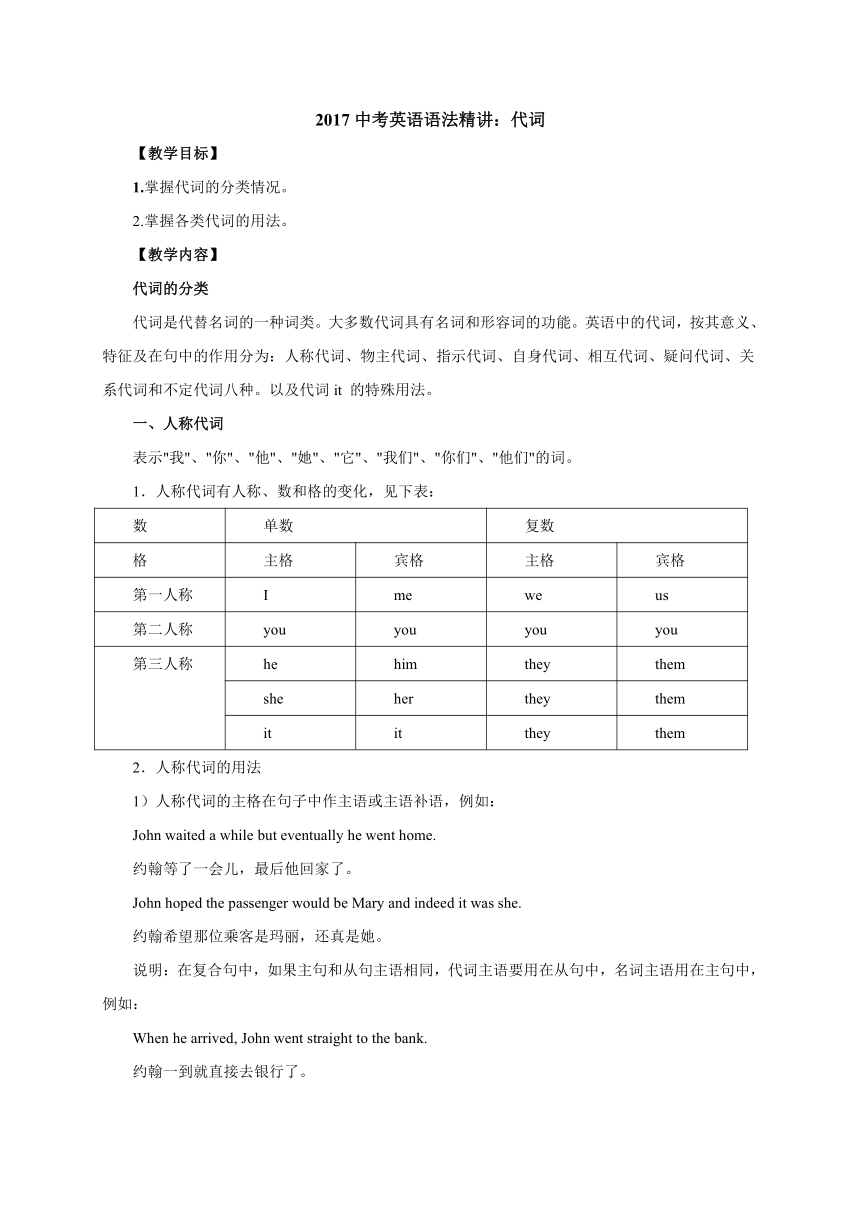
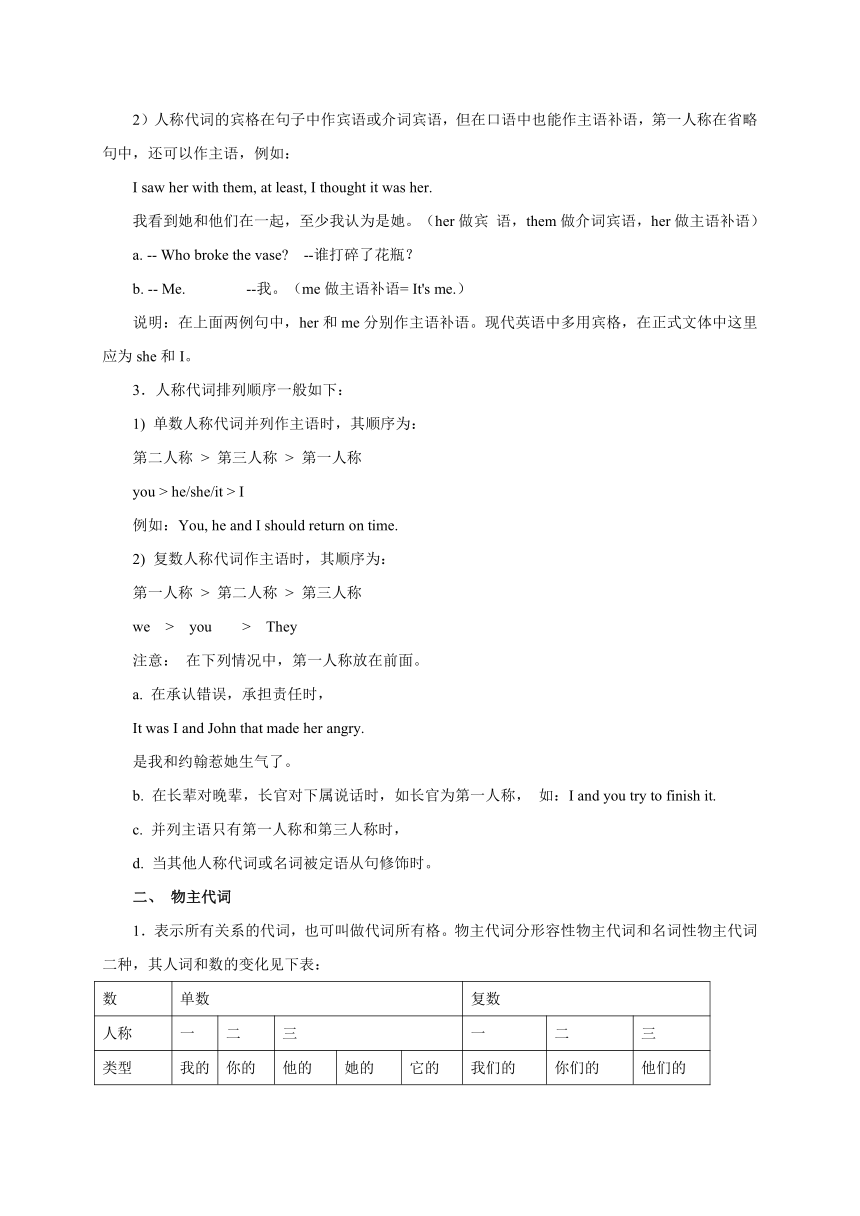
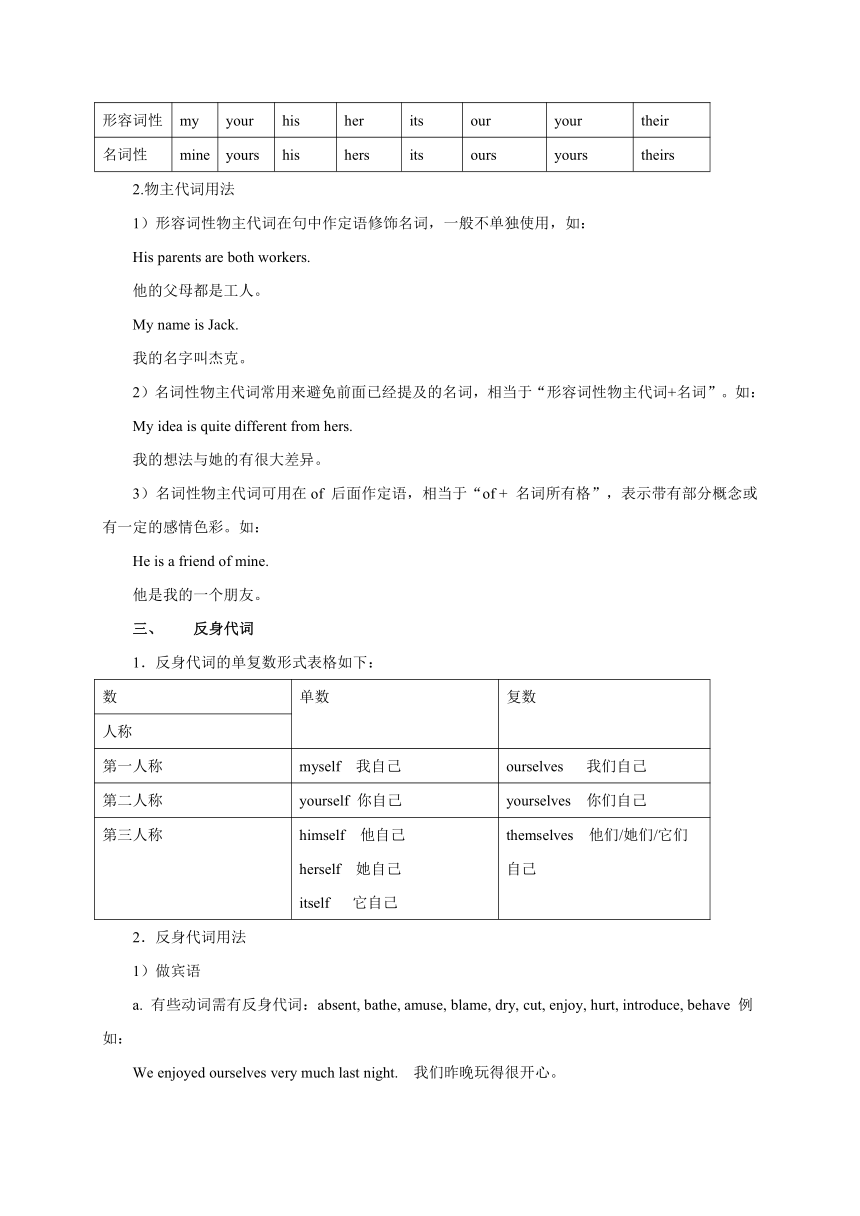
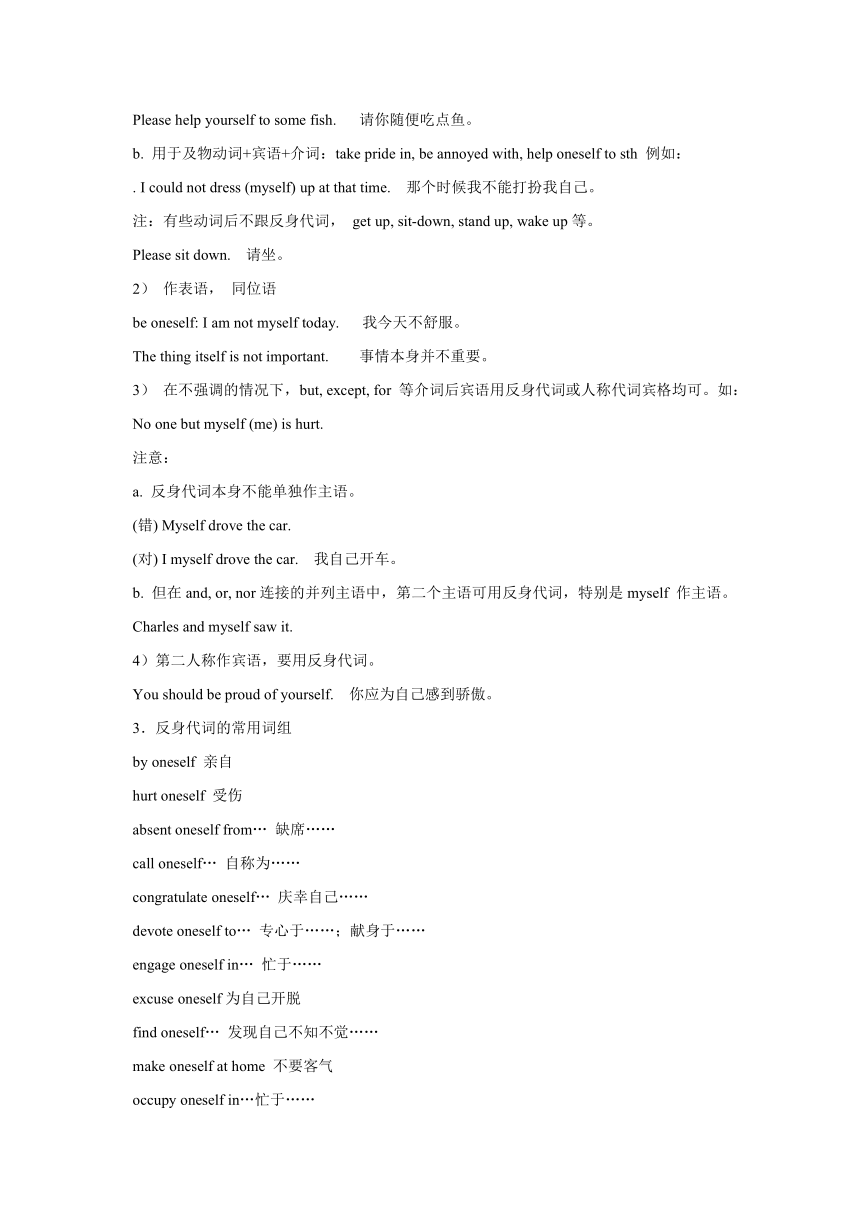
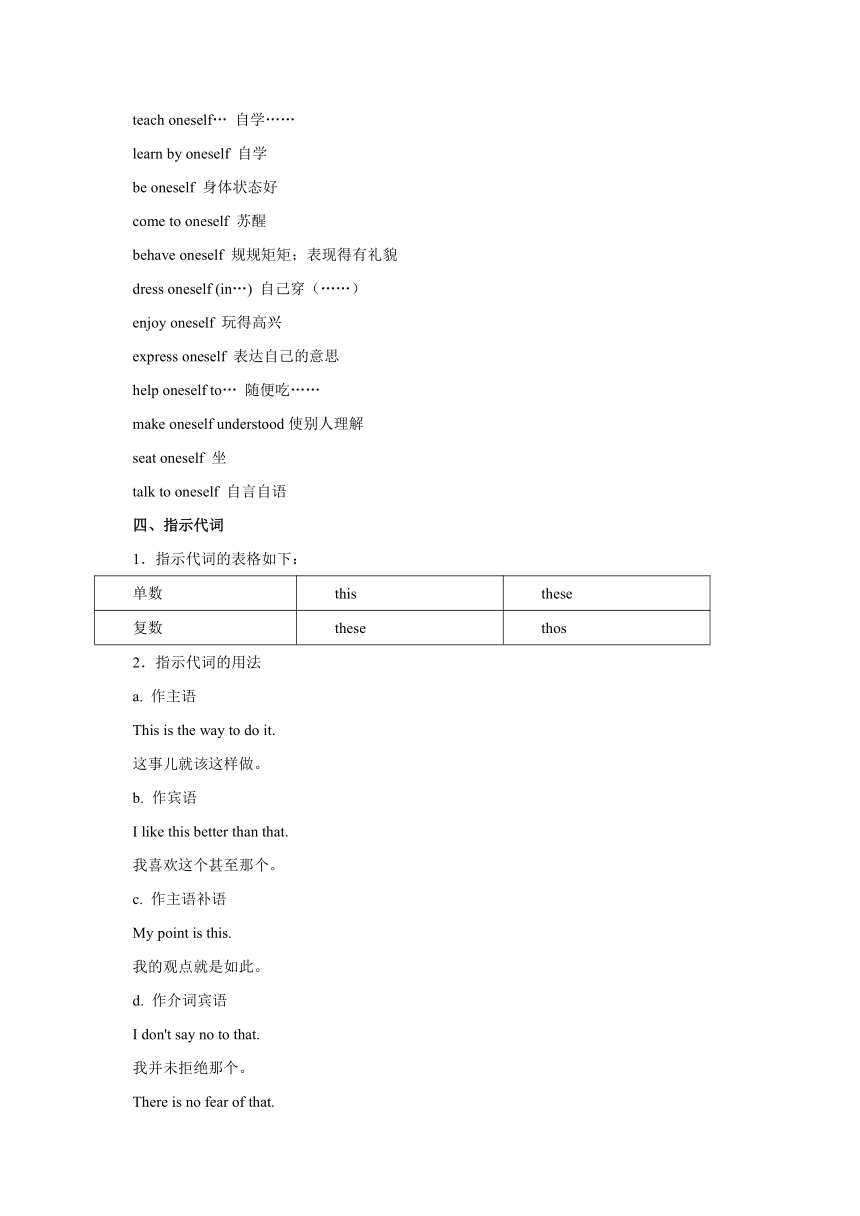
文档简介
2017中考英语语法精讲:代词
【教学目标】
1.掌握代词的分类情况。
2.掌握各类代词的用法。
【教学内容】
代词的分类
代词是代替名词的一种词类。大多数代词具有
( http: / / www.21cnjy.com )名词和形容词的功能。英语中的代词,按其意义、特征及在句中的作用分为:人称代词、物主代词、指示代词、自身代词、相互代词、疑问代词、关系代词和不定代词八种。以及代词it
的特殊用法。
一、人称代词
表示"我"、"你"、"他"、"她"、"它"、"我们"、"你们"、"他们"的词。
1.人称代词有人称、数和格的变化,见下表:
数
单数
复数
格
主格
宾格
主格
宾格
第一人称
I
me
we
us
第二人称
you
you
you
you
第三人称
he
him
they
them
she
her
they
them
it
it
they
them
2.人称代词的用法
1)人称代词的主格在句子中作主语或主语补语,例如:
John
waited
a
while
but
eventually
he
went
home.
约翰等了一会儿,最后他回家了。
John
hoped
the
passenger
would
be
Mary
and
indeed
it
was
she.
约翰希望那位乘客是玛丽,还真是她。
说明:在复合句中,如果主句和从句主语相同,代词主语要用在从句中,名词主语用在主句中,例如:
When
he
arrived,
John
went
straight
to
the
bank.
约翰一到就直接去银行了。
2)人称代词的宾格在句子中作宾语或介词宾语,但在口语中也能作主语补语,第一人称在省略句中,还可以作主语,例如:
I
saw
her
with
them,
at
least,
I
thought
it
was
her.
我看到她和他们在一起,至少我认为是她。(her做宾
语,them做介词宾语,her做主语补语)
a.
--
Who
broke
the
vase --谁打碎了花瓶?
b.
--
Me. --我。(me做主语补语=
It's
me.)
说明:在上面两例句中,her和me分别作主语补语。现代英语中多用宾格,在正式文体中这里应为she和I。
3.人称代词排列顺序一般如下:
1)
单数人称代词并列作主语时,其顺序为:
第二人称
>
第三人称
>
第一人称
you
>
he/she/it
>
I
例如:You,
he
and
I
should
return
on
time.
2)
复数人称代词作主语时,其顺序为:
第一人称
>
第二人称
>
第三人称
we > you > They
注意:
在下列情况中,第一人称放在前面。
a.
在承认错误,承担责任时,
It
was
I
and
John
that
made
her
angry.
是我和约翰惹她生气了。
b.
在长辈对晚辈,长官对下属说话时,如长官为第一人称,
如:I
and
you
try
to
finish
it.
c.
并列主语只有第一人称和第三人称时,
d.
当其他人称代词或名词被定语从句修饰时。
二、
物主代词
1.表示所有关系的代词,也可叫做代词所有格。物主代词分形容性物主代词和名词性物主代词二种,其人词和数的变化见下表:
数
单数
复数
人称
一
二
三
一
二
三
类型
我的
你的
他的
她的
它的
我们的
你们的
他们的
形容词性
my
your
his
her
its
our
your
their
名词性
mine
yours
his
hers
its
ours
yours
theirs
2.物主代词用法
1)形容词性物主代词在句中作定语修饰名词,一般不单独使用,如:
His
parents
are
both
workers.
他的父母都是工人。
My
name
is
Jack.
我的名字叫杰克。
2)名词性物主代词常用来避免前面已经提及的名词,相当于“形容词性物主代词+名词”。如:
My
idea
is
quite
different
from
hers.
我的想法与她的有很大差异。
3)名词性物主代词可用在of
后面作定语,相当于“of
+
名词所有格”,表示带有部分概念或有一定的感彩。如:
He
is
a
friend
of
mine.
他是我的一个朋友。
反身代词
1.反身代词的单复数形式表格如下:
数
单数
复数
人称
第一人称
myself
我自己
ourselves
我们自己
第二人称
yourself
你自己
yourselves
你们自己
第三人称
himself
他自己herself
她自己itself
它自己
themselves
他们/她们/它们自己
2.反身代词用法
1)做宾语
a.
有些动词需有反身代词:absent,
( http: / / www.21cnjy.com )
bathe,
amuse,
blame,
dry,
cut,
enjoy,
hurt,
introduce,
behave
例如:
We
enjoyed
ourselves
very
much
last
night. 我们昨晚玩得很开心。
Please
help
yourself
to
some
fish.
请你随便吃点鱼。
b.
用于及物动词+宾语+介词:take
( http: / / www.21cnjy.com )pride
in,
be
annoyed
with,
help
oneself
to
sth
例如:
.
I
could
not
dress
(myself)
up
at
that
time. 那个时候我不能打扮我自己。
注:有些动词后不跟反身代词,
get
up,
sit-down,
stand
up,
wake
up等。
Please
sit
down. 请坐。
2)
作表语,
同位语
be
oneself:
I
am
not
myself
today.
我今天不舒服。
The
thing
itself
is
not
important. 事情本身并不重要。
3)
在不强调的情况下,but,
except,
for
等介词后宾语用反身代词或人称代词宾格均可。如:
No
one
but
myself
(me)
is
hurt.
注意:
a.
反身代词本身不能单独作主语。
(错)
Myself
drove
the
car.
(对)
I
myself
drove
the
car. 我自己开车。
b.
但在and,
or,
nor连接的并列主语中,第二个主语可用反身代词,特别是myself
作主语。
Charles
and
myself
saw
it.
4)第二人称作宾语,要用反身代词。
You
should
be
proud
of
yourself. 你应为自己感到骄傲。
3.反身代词的常用词组
by
oneself
亲自
hurt
oneself
受伤
absent
oneself
from…
缺席……
call
oneself…
自称为……
congratulate
oneself…
庆幸自己……
devote
oneself
to…
专心于……;献身于……
engage
oneself
in…
忙于……
excuse
oneself为自己开脱
find
oneself…
发现自己不知不觉……
make
oneself
at
home
不要客气
occupy
oneself
in…忙于……
teach
oneself…
自学……
learn
by
oneself
自学
be
oneself
身体状态好
come
to
oneself
苏醒
behave
oneself
规规矩矩;表现得有礼貌
dress
oneself
(in…)
自己穿(……)
enjoy
oneself
玩得高兴
express
oneself
表达自己的意思
help
oneself
to…
随便吃……
make
oneself
understood使别人理解
seat
oneself
坐
talk
to
oneself
自言自语
四、指示代词
1.指示代词的表格如下:
单数
this
these
复数
these
thos
2.指示代词的用法
a.
作主语
This
is
the
way
to
do
it.
这事儿就该这样做。
b.
作宾语
I
like
this
better
than
that.
我喜欢这个甚至那个。
c.
作主语补语
My
point
is
this.
我的观点就是如此。
d.
作介词宾语
I
don't
say
no
to
that.
我并未拒绝那个。
There
is
no
fear
of
that.
那并不可怕。
3.指示代词有this,that,these和those等,使用时要注意以下六点:
1)在时间或空间上近指用this或these,远指用that或those。
2)指上文提到的事一般用that,有时也用this,指下文的事用this,如:
①You
mean
you
don’t
have
enough
money.
That’s
a
problem.
你是说你钱不够。那是个问题。
②They
say
smo
( http: / / www.21cnjy.com )king
is
not
good
for
the
health;
this
I
believe.
人家都说吸烟不利于健康,这一点我相信。
3)打电话时通常用this表示自己,that表示对方。
4)this和that还可作副词用,表示程度,相当于so,如:
①
I
can’t
speak
this
well.?我说不这么好。
②Is
the
box
that
heavy
箱子真的那么重吗?
5)that和those可代替前面提到过的名词,避免重复,但this和these不行,如:
①The
population
of
China
is
larger
than
that
of
Canada.
中国人口比加拿大的多。
②Her
interests
are
( http: / / www.21cnjy.com )different
from
those
of
her
childhood.
她的兴趣和童年时代不同了。
6)That和those可作定语从句的先行词,但this和
these不能,同时,在作先行词时,只有those可指人,
①He
admired
that
which
looked
beautiful.
他欣赏外表漂亮的东西。
②Those(who
were)present
were
given
a
present.
凡是出席的人都得到了一份礼物。
4.一些惯用表达:
this
spring
今年春天
in
those
years
那些年月里
with
this
(that)
这样说着;于是
and
all
that
等等
that
is
to
say
那就是说;即
that
morning
那天早晨
at
this
一听到(见到)这个
for
all
this
(that)
尽管如此;然而仍旧
that
is
说得更精确些;易言之
That’s
that.
就这样决定了。
五、疑问代词的用法
疑问代词
主要用法
例句
who
做主语、表语、宾语(作宾语时在口语中不能放在介词后)
Who
wants
to
go
with
me Who
are
you
whom
who
的宾格形式,作宾语
To
whom
are
you
talking?
whose
who
的所有格形式,作主语、表语、宾语、定语
Whose
book
is
this
what/who
what询问某人的职业
-What’s
your
father -He
is
a
workr.
who
询问某人的身份、姓名
-Who
is
the
boy
under
the
tree -He
is
Li
Ming.
what/which
what指不定数目中的“哪一个,哪一些;什么”,没有一定范围的界限
What
would
you
like
which
“哪一个”,指在一定范围内特指的人或物
Which
one
do
you
like
best
六、不定代词
不定代词分为普通不定代词和复合不定代词
1.初中阶段常用普通不定代词表格如下:
some;
any
few;
little
noneoneother
many;
much
either;
neither
each;
every
both;
all
初中阶段常用复合不定代词列表如下:
somebody(某人)
anybody(某人/任何人)
nobody(没有人)
everybody(每人)
someone(某人)
anybody(某人/任何人)
no
one
(没有人)
everyone(每人)
something(某事)
anything(某事/任何事)
nothing
(没有东西)
everything(每一件事)
2.普通不定代词的用法
I.some,any
some,any既可以修饰可数名词,也可以修饰不可数名词,some常用在肯定句中;any多用于否定句、疑问句及条件句中。
1)some用于表示请求、邀请、建议的疑问句,或希望得到对方肯定回答的疑问句中,如:
①Will
you
have
another
cup
of
tea
再来杯茶好吗?
②Mum,
could
you
give
me
some
money
妈妈,能给我些钱吗?
2)当any表示“任何”或“无论哪一个”的含义时,可用于肯定句,如:
①You
may
come
at
any
time
that
is
convenient
to
you.
你可以在对你方便的任何时候来。
3)some可以修饰单数名词时,表示“某一个”,如:
①He’s
living
in
some
place
in
England.
他住在英国某地。
4)some和any在句中还可用作副词,作状语,some表示“大约”,
any意为“稍微”,如:
①It
happened
some
twenty
years
ago.
这事发生在大约20年前。
②Are
you
feeling
any
better
感觉好点了吗?
5)some,any和
body,
( http: / / www.21cnjy.com )one,thing构成的合成不定代词somebody,someone,something,anybody,anyone,anything和some,any的用法基本相似。
『重点提示』注意anything
but表示“并不,一点也不”,如:
He’s
anything
but
diligent.
他并不用功。
II.many,much,few,little,a
few,a
little
many(很多),a
few(有几个),few(很少)用来代替或修饰可数名词,而much(很多),a
little(有一些),little(很少)用来代替或修饰不可数名词。a
few和a
little含肯定意义,few和little则表示没有多少,含否定意义。一般说来only,just,still,quite等词可与a
few或a
little连用;very,so,some等词可与few或little连用。
『重点提示』a
little与a
bit的区别:
1)a
little
和a
bit都可用来修饰形容词或副词。
2)a
little可直接修饰不可数名词,但a
bit
后要加of
后才可接名词。
3)not
a
little
(=very
much)表示“非常”,而not
a
bit
(=not
at
all)表示“一点也不”。
III.each,every
each和every都可表示“每个”,但含义和用法有所不同。
1)each
指两个或两个以上的人或物中的每一个,强调个体,而every
指三个或三个以上的人或物中的每一个
( http: / / www.21cnjy.com ),侧重整体;each指若干固定数目中的每一个(特指),而every指任何一个(泛指);each兼有代词和形容词特点,可作主语、同位语、定语和宾语,而every是形容词,只能作定语,如:
Each
student
(Each
of
the
students)
has
a
dictionary.
每个学生有一本字典。
Every
competitor
in
the
contest
was
awarded
a
notebook
and
a
pen.
每位参赛选手都获得了一本笔记本和一支钢笔。
2)each作同位语时,不影响谓语动词的数,如:
①We
each
have
a
ticket.
我们每人有张票。(不能用has)
3)every和one可构成合成代词ever
( http: / / www.21cnjy.com )yone与every
one不同。everyone仅指人,后面常跟介词in;every
one既可指人也可指物,后面常接介词of,如:
①Everyone
in
our
class
has
passed
the
test.
我们班每个同学都通过了测试。
The
operation
system
in
every
one
of
the
computers
needs
updating.
每台电脑的操作系统都需要升级。
4)下面的一些表达中只能用every:
every
year
or
two
每一两年
every
other
line
每隔一行
every
five
days
每五天(每隔四天)every
now
and
then
时常
every
few
meters
每几米
every
fifth
day每五天(每隔四天)
IV.none,no
one,nothing
1)none既可指人也可指
( http: / / www.21cnjy.com )物,常暗示一定范围,因此多与表示范围的介词of
短语连用;no
one只能指人,不能与of
短语连用,但可接介词in引起的短语。
2)none与数量有关,
( http: / / www.21cnjy.com )可回答how
many或how
much,表示“一个也没有”;
no
one表示“什么人也没有”,可回答who;nothing表示“什么也没有”,用来否定一切,可回答what,如:
①—How
many
people
are
there
in
the
room
房间里有多少人?
—None.
一个没有。
②—Who
is
in
the
office
谁在办公室?
—No
one.
没有人。
③—What
did
you
do
last
night
昨晚你干了些什么?
—Nothing.
什么也没干。
『重点提示』注意nothing和none的一些搭配:
all
to
nothing
一定
for
nothing
徒劳,免费
be
nothing
to
对……无所谓
to
say
nothing
of
更谈不到……
go
for
nothing
白费;没有价值
have
nothing
to
do
but
do
sth.
只有做……
There
is
nothing
to
do
sth.
没什么好……
none
other
than
不是别的正是……
none
too
不太……;一点都不……
none
the+比较级+for
毫不……
nothing
but
仅仅……;只不过……
nothing
if
not
非常……
come
to
nothing
没有结果;失败
think
nothing
of
认为……算不了什么
have
nothing
to
do
with
和……无关
There
is
nothing
in
it.
那根本没有道理。
have
none
of
不准……;不接受……
none
but
只有……
none
the
wiser
不知情
It’s
none
of
your
business.
不关你的事。
V.all,both,neither,either
all指三者以上“都”。both,ne
( http: / / www.21cnjy.com )ither和either都涉及两个人或事物的关系,both意为“两者都”,neither意为“两者都不”,either表示“两者中任何一个”。常构成固定搭配either/neither
of
+名词(代词)的复数+谓语动词(第三人称单数);当either
…or…
和
neither…nor…
连接两个主语时,谓语动词应与离它最近的主语在人称和数上保持一致。如:
Neither
of
the
books
is
good.
这两本书都不好。
Neither
you
nor
he
is
wrong.
你们两个都没有错。
both
常和and
连用;all
常与of
连用;all和both与not一起连用是表示部分否定。如:
Both
she
and
I
are
students.
她和我都是学生。
All
of
the
students
are
going
to
travel.
所有的学生将去旅游。
Not
all
the
students
like
playing
football.
不是所有的学生都喜欢踢足球。
VI.other,the
other,others,the
others,another
不定代词
意义
用法说明
例句
other
其他的;别的;另外的
常用作定语,修饰复数可数名词或不可数名
( http: / / www.21cnjy.com )词。但如果other前有the,some,any,another,every,no,my等词时,可与单数可数名词连用
I’ll
come
some
other
day.
我改日来。
the
other
两者中余下的那个
可与one构成“one...the
other…结构;作定语修饰复数名词时,表示“其余的全部”
He
has
two
daughters
( http: / / www.21cnjy.com ).
One
is
a
nurse,
the
other
is
a
teacher.
他有两个女儿,一个是护士,另一个是教师。I
bought
three
pens.
One
is
red,
the
other
two
are
blue.
我买了三支钢笔。一支红色的,其它两支是蓝色的。
others
泛指其他的人或物
是other
的复数形式,不能做定语,常与some搭配构成some…others…结构
Some
students
like
painting,
others
enjoy
music.一些人喜欢画画,其他人喜欢音乐。
the
others
特指某范围内其余的人或物
是the
other
的复数形式
We
got
home
by
4
o’clock,
but
the
others
didn’t
get
back
until
8.我们到4点就回家了,其余的人直到8点才回来。
another
相当于an
other,泛指三者或三者以上中的另一个,任何一个
一般用来泛指三者或三者以上中的另一个,代替或修饰单数可数名词。如果another后有few或数词时,可接复数名词
We
need
another
five
days
(=five
more
days).我们还需要五天。
七、关系代词
有who,whom,whose,th
( http: / / www.21cnjy.com )at,which,as等,可用作引导从句的关联词。它们在定语从句中可作主语、表语、宾语、定语等;另一方面它们又代表主句中为定语从句所修饰的那个名词或代词(通称为先行词)。如:
He
is
the
man
whom
you
have
been
looking
for.
他就是你要找的那个人。
八、互相代词
表示相互关系的代词叫相互代词,有each
other
和one
another两组,但在运用中,这两组词没什么区别。
如:
They
love
each
other. 他们彼此相爱。
九、代词it
的用法
1.指代前面提到过的事物。如:
The
book
on
the
desk
is
not
mine.
It
is
Jim’s.
桌子上的书不是我的,它是吉姆的。
2.指代指示代词this
或
that。如:
-What’s
that
-It
is
a
pencil.
那是什么?那是一支笔。
3.指代婴儿或不明身份的人。如:
Someone
is
knocking
at
the
door.
Please
go
and
see
who
it
is.
有人在敲门,去看看他是谁。
4.指代时间或季节。如:
-What’s
the
time
now
-It’s
ten
o’clock.
现在几点了?十点了。
5.指代天气。如:
-What’s
the
weather
like
today
-It’s
sunny.
今天天气怎样?天气晴朗。
6.指代距离。如:
How
far
is
it
from
your
school
to
your
home
从学校到你家有多远?
7.用作形式主语,常用于下列句型中:
1)It
is
+
adj.
+
(for
sb.)
to
do
sth.
如:
It
is
important
for
us
to
work
hard.
对我们而言努力工作是很重要的。
It’s
time
to
do/for/that…
如:
It’s
time
to
get
up.
该起床了。
It’s
time
for
lunch.
该吃午饭了。
It’s
time
that
we
went
home.
我们该回家了。
It
seems
that…
看起来好像…
It’s
one’s
turn
to
do
…
轮到某人做……
如:
It’s
your
turn
to
sing.
该轮到你唱歌了。
It’s
+adj.
+that
从句
8.
作形式宾语。如:
Do
you
think
it
necessary
to
learn
English
你认为学习英语是必要的吗?
9.引导强调句型“It
is/was
+
被强调部分
+
that/who/whom
+
其他成分”。如:
It
is
our
hope
that
our
city
will
become
more
and
more
beautiful.
我们的希望是我们的城市越来越漂亮。
【课内检测】详见导学案
【作业布置】
1.完成本节课的《同步练习》
2.预习下一讲的导学案。
【教学目标】
1.掌握代词的分类情况。
2.掌握各类代词的用法。
【教学内容】
代词的分类
代词是代替名词的一种词类。大多数代词具有
( http: / / www.21cnjy.com )名词和形容词的功能。英语中的代词,按其意义、特征及在句中的作用分为:人称代词、物主代词、指示代词、自身代词、相互代词、疑问代词、关系代词和不定代词八种。以及代词it
的特殊用法。
一、人称代词
表示"我"、"你"、"他"、"她"、"它"、"我们"、"你们"、"他们"的词。
1.人称代词有人称、数和格的变化,见下表:
数
单数
复数
格
主格
宾格
主格
宾格
第一人称
I
me
we
us
第二人称
you
you
you
you
第三人称
he
him
they
them
she
her
they
them
it
it
they
them
2.人称代词的用法
1)人称代词的主格在句子中作主语或主语补语,例如:
John
waited
a
while
but
eventually
he
went
home.
约翰等了一会儿,最后他回家了。
John
hoped
the
passenger
would
be
Mary
and
indeed
it
was
she.
约翰希望那位乘客是玛丽,还真是她。
说明:在复合句中,如果主句和从句主语相同,代词主语要用在从句中,名词主语用在主句中,例如:
When
he
arrived,
John
went
straight
to
the
bank.
约翰一到就直接去银行了。
2)人称代词的宾格在句子中作宾语或介词宾语,但在口语中也能作主语补语,第一人称在省略句中,还可以作主语,例如:
I
saw
her
with
them,
at
least,
I
thought
it
was
her.
我看到她和他们在一起,至少我认为是她。(her做宾
语,them做介词宾语,her做主语补语)
a.
--
Who
broke
the
vase --谁打碎了花瓶?
b.
--
Me. --我。(me做主语补语=
It's
me.)
说明:在上面两例句中,her和me分别作主语补语。现代英语中多用宾格,在正式文体中这里应为she和I。
3.人称代词排列顺序一般如下:
1)
单数人称代词并列作主语时,其顺序为:
第二人称
>
第三人称
>
第一人称
you
>
he/she/it
>
I
例如:You,
he
and
I
should
return
on
time.
2)
复数人称代词作主语时,其顺序为:
第一人称
>
第二人称
>
第三人称
we > you > They
注意:
在下列情况中,第一人称放在前面。
a.
在承认错误,承担责任时,
It
was
I
and
John
that
made
her
angry.
是我和约翰惹她生气了。
b.
在长辈对晚辈,长官对下属说话时,如长官为第一人称,
如:I
and
you
try
to
finish
it.
c.
并列主语只有第一人称和第三人称时,
d.
当其他人称代词或名词被定语从句修饰时。
二、
物主代词
1.表示所有关系的代词,也可叫做代词所有格。物主代词分形容性物主代词和名词性物主代词二种,其人词和数的变化见下表:
数
单数
复数
人称
一
二
三
一
二
三
类型
我的
你的
他的
她的
它的
我们的
你们的
他们的
形容词性
my
your
his
her
its
our
your
their
名词性
mine
yours
his
hers
its
ours
yours
theirs
2.物主代词用法
1)形容词性物主代词在句中作定语修饰名词,一般不单独使用,如:
His
parents
are
both
workers.
他的父母都是工人。
My
name
is
Jack.
我的名字叫杰克。
2)名词性物主代词常用来避免前面已经提及的名词,相当于“形容词性物主代词+名词”。如:
My
idea
is
quite
different
from
hers.
我的想法与她的有很大差异。
3)名词性物主代词可用在of
后面作定语,相当于“of
+
名词所有格”,表示带有部分概念或有一定的感彩。如:
He
is
a
friend
of
mine.
他是我的一个朋友。
反身代词
1.反身代词的单复数形式表格如下:
数
单数
复数
人称
第一人称
myself
我自己
ourselves
我们自己
第二人称
yourself
你自己
yourselves
你们自己
第三人称
himself
他自己herself
她自己itself
它自己
themselves
他们/她们/它们自己
2.反身代词用法
1)做宾语
a.
有些动词需有反身代词:absent,
( http: / / www.21cnjy.com )
bathe,
amuse,
blame,
dry,
cut,
enjoy,
hurt,
introduce,
behave
例如:
We
enjoyed
ourselves
very
much
last
night. 我们昨晚玩得很开心。
Please
help
yourself
to
some
fish.
请你随便吃点鱼。
b.
用于及物动词+宾语+介词:take
( http: / / www.21cnjy.com )pride
in,
be
annoyed
with,
help
oneself
to
sth
例如:
.
I
could
not
dress
(myself)
up
at
that
time. 那个时候我不能打扮我自己。
注:有些动词后不跟反身代词,
get
up,
sit-down,
stand
up,
wake
up等。
Please
sit
down. 请坐。
2)
作表语,
同位语
be
oneself:
I
am
not
myself
today.
我今天不舒服。
The
thing
itself
is
not
important. 事情本身并不重要。
3)
在不强调的情况下,but,
except,
for
等介词后宾语用反身代词或人称代词宾格均可。如:
No
one
but
myself
(me)
is
hurt.
注意:
a.
反身代词本身不能单独作主语。
(错)
Myself
drove
the
car.
(对)
I
myself
drove
the
car. 我自己开车。
b.
但在and,
or,
nor连接的并列主语中,第二个主语可用反身代词,特别是myself
作主语。
Charles
and
myself
saw
it.
4)第二人称作宾语,要用反身代词。
You
should
be
proud
of
yourself. 你应为自己感到骄傲。
3.反身代词的常用词组
by
oneself
亲自
hurt
oneself
受伤
absent
oneself
from…
缺席……
call
oneself…
自称为……
congratulate
oneself…
庆幸自己……
devote
oneself
to…
专心于……;献身于……
engage
oneself
in…
忙于……
excuse
oneself为自己开脱
find
oneself…
发现自己不知不觉……
make
oneself
at
home
不要客气
occupy
oneself
in…忙于……
teach
oneself…
自学……
learn
by
oneself
自学
be
oneself
身体状态好
come
to
oneself
苏醒
behave
oneself
规规矩矩;表现得有礼貌
dress
oneself
(in…)
自己穿(……)
enjoy
oneself
玩得高兴
express
oneself
表达自己的意思
help
oneself
to…
随便吃……
make
oneself
understood使别人理解
seat
oneself
坐
talk
to
oneself
自言自语
四、指示代词
1.指示代词的表格如下:
单数
this
these
复数
these
thos
2.指示代词的用法
a.
作主语
This
is
the
way
to
do
it.
这事儿就该这样做。
b.
作宾语
I
like
this
better
than
that.
我喜欢这个甚至那个。
c.
作主语补语
My
point
is
this.
我的观点就是如此。
d.
作介词宾语
I
don't
say
no
to
that.
我并未拒绝那个。
There
is
no
fear
of
that.
那并不可怕。
3.指示代词有this,that,these和those等,使用时要注意以下六点:
1)在时间或空间上近指用this或these,远指用that或those。
2)指上文提到的事一般用that,有时也用this,指下文的事用this,如:
①You
mean
you
don’t
have
enough
money.
That’s
a
problem.
你是说你钱不够。那是个问题。
②They
say
smo
( http: / / www.21cnjy.com )king
is
not
good
for
the
health;
this
I
believe.
人家都说吸烟不利于健康,这一点我相信。
3)打电话时通常用this表示自己,that表示对方。
4)this和that还可作副词用,表示程度,相当于so,如:
①
I
can’t
speak
this
well.?我说不这么好。
②Is
the
box
that
heavy
箱子真的那么重吗?
5)that和those可代替前面提到过的名词,避免重复,但this和these不行,如:
①The
population
of
China
is
larger
than
that
of
Canada.
中国人口比加拿大的多。
②Her
interests
are
( http: / / www.21cnjy.com )different
from
those
of
her
childhood.
她的兴趣和童年时代不同了。
6)That和those可作定语从句的先行词,但this和
these不能,同时,在作先行词时,只有those可指人,
①He
admired
that
which
looked
beautiful.
他欣赏外表漂亮的东西。
②Those(who
were)present
were
given
a
present.
凡是出席的人都得到了一份礼物。
4.一些惯用表达:
this
spring
今年春天
in
those
years
那些年月里
with
this
(that)
这样说着;于是
and
all
that
等等
that
is
to
say
那就是说;即
that
morning
那天早晨
at
this
一听到(见到)这个
for
all
this
(that)
尽管如此;然而仍旧
that
is
说得更精确些;易言之
That’s
that.
就这样决定了。
五、疑问代词的用法
疑问代词
主要用法
例句
who
做主语、表语、宾语(作宾语时在口语中不能放在介词后)
Who
wants
to
go
with
me Who
are
you
whom
who
的宾格形式,作宾语
To
whom
are
you
talking?
whose
who
的所有格形式,作主语、表语、宾语、定语
Whose
book
is
this
what/who
what询问某人的职业
-What’s
your
father -He
is
a
workr.
who
询问某人的身份、姓名
-Who
is
the
boy
under
the
tree -He
is
Li
Ming.
what/which
what指不定数目中的“哪一个,哪一些;什么”,没有一定范围的界限
What
would
you
like
which
“哪一个”,指在一定范围内特指的人或物
Which
one
do
you
like
best
六、不定代词
不定代词分为普通不定代词和复合不定代词
1.初中阶段常用普通不定代词表格如下:
some;
any
few;
little
noneoneother
many;
much
either;
neither
each;
every
both;
all
初中阶段常用复合不定代词列表如下:
somebody(某人)
anybody(某人/任何人)
nobody(没有人)
everybody(每人)
someone(某人)
anybody(某人/任何人)
no
one
(没有人)
everyone(每人)
something(某事)
anything(某事/任何事)
nothing
(没有东西)
everything(每一件事)
2.普通不定代词的用法
I.some,any
some,any既可以修饰可数名词,也可以修饰不可数名词,some常用在肯定句中;any多用于否定句、疑问句及条件句中。
1)some用于表示请求、邀请、建议的疑问句,或希望得到对方肯定回答的疑问句中,如:
①Will
you
have
another
cup
of
tea
再来杯茶好吗?
②Mum,
could
you
give
me
some
money
妈妈,能给我些钱吗?
2)当any表示“任何”或“无论哪一个”的含义时,可用于肯定句,如:
①You
may
come
at
any
time
that
is
convenient
to
you.
你可以在对你方便的任何时候来。
3)some可以修饰单数名词时,表示“某一个”,如:
①He’s
living
in
some
place
in
England.
他住在英国某地。
4)some和any在句中还可用作副词,作状语,some表示“大约”,
any意为“稍微”,如:
①It
happened
some
twenty
years
ago.
这事发生在大约20年前。
②Are
you
feeling
any
better
感觉好点了吗?
5)some,any和
body,
( http: / / www.21cnjy.com )one,thing构成的合成不定代词somebody,someone,something,anybody,anyone,anything和some,any的用法基本相似。
『重点提示』注意anything
but表示“并不,一点也不”,如:
He’s
anything
but
diligent.
他并不用功。
II.many,much,few,little,a
few,a
little
many(很多),a
few(有几个),few(很少)用来代替或修饰可数名词,而much(很多),a
little(有一些),little(很少)用来代替或修饰不可数名词。a
few和a
little含肯定意义,few和little则表示没有多少,含否定意义。一般说来only,just,still,quite等词可与a
few或a
little连用;very,so,some等词可与few或little连用。
『重点提示』a
little与a
bit的区别:
1)a
little
和a
bit都可用来修饰形容词或副词。
2)a
little可直接修饰不可数名词,但a
bit
后要加of
后才可接名词。
3)not
a
little
(=very
much)表示“非常”,而not
a
bit
(=not
at
all)表示“一点也不”。
III.each,every
each和every都可表示“每个”,但含义和用法有所不同。
1)each
指两个或两个以上的人或物中的每一个,强调个体,而every
指三个或三个以上的人或物中的每一个
( http: / / www.21cnjy.com ),侧重整体;each指若干固定数目中的每一个(特指),而every指任何一个(泛指);each兼有代词和形容词特点,可作主语、同位语、定语和宾语,而every是形容词,只能作定语,如:
Each
student
(Each
of
the
students)
has
a
dictionary.
每个学生有一本字典。
Every
competitor
in
the
contest
was
awarded
a
notebook
and
a
pen.
每位参赛选手都获得了一本笔记本和一支钢笔。
2)each作同位语时,不影响谓语动词的数,如:
①We
each
have
a
ticket.
我们每人有张票。(不能用has)
3)every和one可构成合成代词ever
( http: / / www.21cnjy.com )yone与every
one不同。everyone仅指人,后面常跟介词in;every
one既可指人也可指物,后面常接介词of,如:
①Everyone
in
our
class
has
passed
the
test.
我们班每个同学都通过了测试。
The
operation
system
in
every
one
of
the
computers
needs
updating.
每台电脑的操作系统都需要升级。
4)下面的一些表达中只能用every:
every
year
or
two
每一两年
every
other
line
每隔一行
every
five
days
每五天(每隔四天)every
now
and
then
时常
every
few
meters
每几米
every
fifth
day每五天(每隔四天)
IV.none,no
one,nothing
1)none既可指人也可指
( http: / / www.21cnjy.com )物,常暗示一定范围,因此多与表示范围的介词of
短语连用;no
one只能指人,不能与of
短语连用,但可接介词in引起的短语。
2)none与数量有关,
( http: / / www.21cnjy.com )可回答how
many或how
much,表示“一个也没有”;
no
one表示“什么人也没有”,可回答who;nothing表示“什么也没有”,用来否定一切,可回答what,如:
①—How
many
people
are
there
in
the
room
房间里有多少人?
—None.
一个没有。
②—Who
is
in
the
office
谁在办公室?
—No
one.
没有人。
③—What
did
you
do
last
night
昨晚你干了些什么?
—Nothing.
什么也没干。
『重点提示』注意nothing和none的一些搭配:
all
to
nothing
一定
for
nothing
徒劳,免费
be
nothing
to
对……无所谓
to
say
nothing
of
更谈不到……
go
for
nothing
白费;没有价值
have
nothing
to
do
but
do
sth.
只有做……
There
is
nothing
to
do
sth.
没什么好……
none
other
than
不是别的正是……
none
too
不太……;一点都不……
none
the+比较级+for
毫不……
nothing
but
仅仅……;只不过……
nothing
if
not
非常……
come
to
nothing
没有结果;失败
think
nothing
of
认为……算不了什么
have
nothing
to
do
with
和……无关
There
is
nothing
in
it.
那根本没有道理。
have
none
of
不准……;不接受……
none
but
只有……
none
the
wiser
不知情
It’s
none
of
your
business.
不关你的事。
V.all,both,neither,either
all指三者以上“都”。both,ne
( http: / / www.21cnjy.com )ither和either都涉及两个人或事物的关系,both意为“两者都”,neither意为“两者都不”,either表示“两者中任何一个”。常构成固定搭配either/neither
of
+名词(代词)的复数+谓语动词(第三人称单数);当either
…or…
和
neither…nor…
连接两个主语时,谓语动词应与离它最近的主语在人称和数上保持一致。如:
Neither
of
the
books
is
good.
这两本书都不好。
Neither
you
nor
he
is
wrong.
你们两个都没有错。
both
常和and
连用;all
常与of
连用;all和both与not一起连用是表示部分否定。如:
Both
she
and
I
are
students.
她和我都是学生。
All
of
the
students
are
going
to
travel.
所有的学生将去旅游。
Not
all
the
students
like
playing
football.
不是所有的学生都喜欢踢足球。
VI.other,the
other,others,the
others,another
不定代词
意义
用法说明
例句
other
其他的;别的;另外的
常用作定语,修饰复数可数名词或不可数名
( http: / / www.21cnjy.com )词。但如果other前有the,some,any,another,every,no,my等词时,可与单数可数名词连用
I’ll
come
some
other
day.
我改日来。
the
other
两者中余下的那个
可与one构成“one...the
other…结构;作定语修饰复数名词时,表示“其余的全部”
He
has
two
daughters
( http: / / www.21cnjy.com ).
One
is
a
nurse,
the
other
is
a
teacher.
他有两个女儿,一个是护士,另一个是教师。I
bought
three
pens.
One
is
red,
the
other
two
are
blue.
我买了三支钢笔。一支红色的,其它两支是蓝色的。
others
泛指其他的人或物
是other
的复数形式,不能做定语,常与some搭配构成some…others…结构
Some
students
like
painting,
others
enjoy
music.一些人喜欢画画,其他人喜欢音乐。
the
others
特指某范围内其余的人或物
是the
other
的复数形式
We
got
home
by
4
o’clock,
but
the
others
didn’t
get
back
until
8.我们到4点就回家了,其余的人直到8点才回来。
another
相当于an
other,泛指三者或三者以上中的另一个,任何一个
一般用来泛指三者或三者以上中的另一个,代替或修饰单数可数名词。如果another后有few或数词时,可接复数名词
We
need
another
five
days
(=five
more
days).我们还需要五天。
七、关系代词
有who,whom,whose,th
( http: / / www.21cnjy.com )at,which,as等,可用作引导从句的关联词。它们在定语从句中可作主语、表语、宾语、定语等;另一方面它们又代表主句中为定语从句所修饰的那个名词或代词(通称为先行词)。如:
He
is
the
man
whom
you
have
been
looking
for.
他就是你要找的那个人。
八、互相代词
表示相互关系的代词叫相互代词,有each
other
和one
another两组,但在运用中,这两组词没什么区别。
如:
They
love
each
other. 他们彼此相爱。
九、代词it
的用法
1.指代前面提到过的事物。如:
The
book
on
the
desk
is
not
mine.
It
is
Jim’s.
桌子上的书不是我的,它是吉姆的。
2.指代指示代词this
或
that。如:
-What’s
that
-It
is
a
pencil.
那是什么?那是一支笔。
3.指代婴儿或不明身份的人。如:
Someone
is
knocking
at
the
door.
Please
go
and
see
who
it
is.
有人在敲门,去看看他是谁。
4.指代时间或季节。如:
-What’s
the
time
now
-It’s
ten
o’clock.
现在几点了?十点了。
5.指代天气。如:
-What’s
the
weather
like
today
-It’s
sunny.
今天天气怎样?天气晴朗。
6.指代距离。如:
How
far
is
it
from
your
school
to
your
home
从学校到你家有多远?
7.用作形式主语,常用于下列句型中:
1)It
is
+
adj.
+
(for
sb.)
to
do
sth.
如:
It
is
important
for
us
to
work
hard.
对我们而言努力工作是很重要的。
It’s
time
to
do/for/that…
如:
It’s
time
to
get
up.
该起床了。
It’s
time
for
lunch.
该吃午饭了。
It’s
time
that
we
went
home.
我们该回家了。
It
seems
that…
看起来好像…
It’s
one’s
turn
to
do
…
轮到某人做……
如:
It’s
your
turn
to
sing.
该轮到你唱歌了。
It’s
+adj.
+that
从句
8.
作形式宾语。如:
Do
you
think
it
necessary
to
learn
English
你认为学习英语是必要的吗?
9.引导强调句型“It
is/was
+
被强调部分
+
that/who/whom
+
其他成分”。如:
It
is
our
hope
that
our
city
will
become
more
and
more
beautiful.
我们的希望是我们的城市越来越漂亮。
【课内检测】详见导学案
【作业布置】
1.完成本节课的《同步练习》
2.预习下一讲的导学案。
同课章节目录
- 词法
- 名词
- 动词和动词短语
- 动词语态
- 动词时态
- 助动词和情态动词
- 非谓语动词
- 冠词
- 代词
- 数词和量词
- 形容词副词及其比较等级
- 介词和介词短语
- 连词和感叹词
- 构词法
- 相似、相近词比较
- 句法
- 陈述句
- 一般疑问句和否定疑问句
- 特殊疑问句及选择疑问句
- 反意疑问句
- 存在句(There be句型)
- 宾语从句
- 定语从句
- 状语从句
- 主谓一致问题
- 简单句
- 并列句
- 复合句
- 主谓一致
- 主、表语从句
- 名词性从句
- 直接引语和间接引语
- 虚拟语气
- 感叹句
- 强调句
- 倒装句
- 祈使句
- 句子的成分
- 句子的分类
- 题型专区
- 单项选择部分
- 易错题
- 完形填空
- 阅读理解
- 词汇练习
- 听说训练
- 句型转换
- 补全对话
- 短文改错
- 翻译
- 书面表达
- 任务型阅读
- 语法填空
- 其他资料
